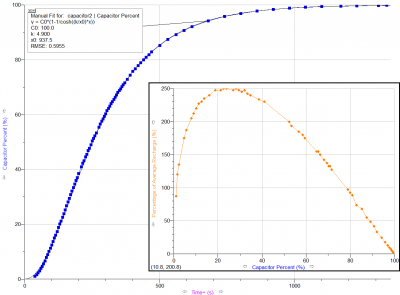Talk:Capacitor recharge rate
Experiments
Cleaning the page. I'll move the info on experiments here. They stay in history too but easier for someone to see them here Hirmuolio pine (talk) 13:23, 15 March 2017 (CDT)
More recent testing by Kivena
Here's a big graph of current capacitor capacity (in percentage) over time since being drained to zero. The blue points are data points from my experiments. The black line is an equation based on Dust Puppy's research (see link at top of this page) which you can see at the top left corner of the image.
- C0 is 100, being as our maximum capacitor capacitor is always 100%.
- x0 is the "Capacitor Recharge Time" in seconds, according to the in-game Show Info (x being, obviously, the current time since the capacitor was drained to zero)
- k is a constant (in Seamus' and Dust Puppy's calculations, they used it in a τ = x0/k format) that Dust Puppy calculated as 4.8, Seamus worked out as 5.0, but I found 4.9 fitted a little better.
It's still not exactly right near zero, but the rest, after around 7-8% capacity, fits it perfectly.
The smaller inset graph (orange) shows a percentage of average recharge rate over current capacitor percentage, thus indicating how quickly the capacitor recharges as your energy restores. I didn't try to equationize (this is now a word) this one, but you can clearly see that the maximum capacitor recharge is 2.5x the average recharge, and that this occurs at 25% of capacitor capacity.
Using the second capacitor equation (dC/dt = ...) to calculate the Tau ratio and comparing it to ingame values
This approach assumes two things:
1) That the second equation above is correct
2) That the EVE fitting window shows an accurate value (rounded to one decimal point) for peak recharge.
Peak recharge: By taking the derivative of C in the dC/dt equation and setting the expression to 0, the value of C at peak recharge can be found. This turns out to be C = Cmax/4 (at 25% capacitor), as Seamus had already pointed out.
Entering this value of C into the dC/dt equation gives:
dC/dt (peak) = Cmax/(2*Tau)
What we are looking for is the Tau ratio, which is
"Cap recharge time" / Tau = constant
where this ratio has been suggested to be 4.8 , 4.9 or 5.0
edit: CCP Larrikin confirmed on 14 nov 2016 that the constant is 5.0
dC/dt (peak) = Cmax/(2*Tau) = Cmax/(2 * "Cap recharge time" / constant) = (constant/2)*(Cmax / "Cap recharge time")
We can now write three equations for each of the suggested ratios
4.8 -> dC/dt (peak) = 2.40*Cmax/"Cap recharge time"
4.9 -> dC/dt (peak) = 2.45*Cmax/"Cap recharge time"
5.0 -> dC/dt (peak) = 2.50*Cmax/"Cap recharge time"
Next step is to test which value that fits best with the values from the fitting window in EVE. A Slasher has 120s recharge time and 240 total capacitor by default. With the skills Capacitor Management and Capacitor Systems Operation both trained to 5, these values change to 90s recharge time and 300 total capacitor (exact values, no rounding). According to the fitting window this Slasher (no modules or rigs fitted and skills at 5) has a capacitor of Δ8.3 (100%). This is the peak recharge value rounded off to one decimal point. Which of the three equations above gives a peak recharge of 8.3 then?
4.8 -> dC/dt (peak) = 2.40*Cmax/"Cap recharge time" = 2.40*300/90 = 8.000
4.9 -> dC/dt (peak) = 2.45*Cmax/"Cap recharge time" = 2.45*300/90 = 8.167
5.0 -> dC/dt (peak) = 2.50*Cmax/"Cap recharge time" = 2.50*300/90 = 8.333
Seamus constant of 5 leads to the same peak recharge value that is seen in the game.
edit:
Kivena's orange graph above reaches a maximum value of 250%, same as 2.5. By doing what Kivena did, setting Cmax and "Cap recharge time" both to 100%, which means they cancel eachother out, the following expression is reached
dC/dt (peak) = constant / 2 * (Cmax / "Cap recharge time") = constant / 2
This can only be 2.5 if the constant = 5. So the orange graph is spot on. It's just the line fit of the blue graph that gives a lower value, perhaps something that can be traced back to a measuring error near the end points or even that the computer program used somehow failed.
